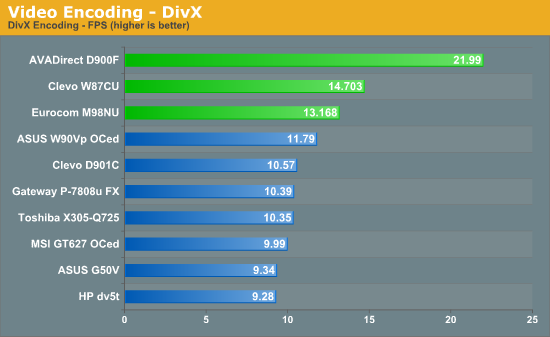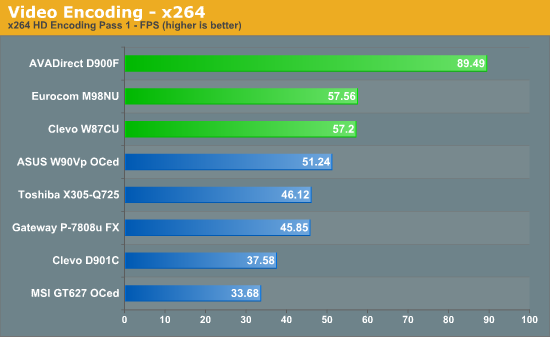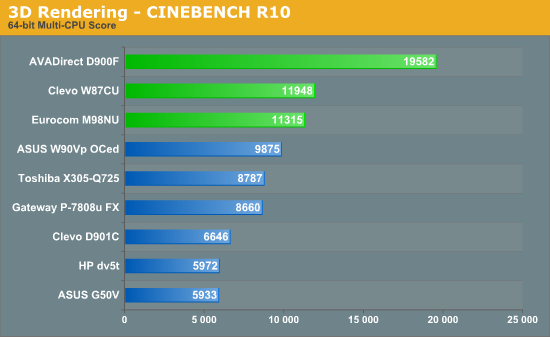The Highest-End Notebooks, 2009
by Jarred Walton on October 14, 2009 3:10 AM ESTSystem Performance
We'll begin with a look at general system performance using PCMark and applications that can take advantage of the multi-core processors.







The three desktop replacement notebooks place at the top of our performance charts in PCMark, video encoding, and 3D rendering benchmarks. Not surprisingly, the desktop i7-975 offers far more performance in video encoding and 3D rendering tests. The i7-920XM also outperforms the Core 2 QX9300 in CPU intensive tasks despite its lower clock speed, albeit by a small margin, so given the choice Core i7 is better than Core 2 Quad. However, let's talk about PCMark for a minute.
The Eurocom M980NU looks very slow compared to the two other notebooks in PCMark. The reason is really quite simple: it doesn't have an SSD. Eurocom initially shipped us a system with an SSD, but we had some problems (apparently a flaky GPU) and the second system included a conventional hard drive. While there's no denying that SSDs are faster than hard drives, at least if you get a good SSD that doesn't degrade performance over time, PCMark places an unusually high weight on hard drive transfer rates -- which means things like the RAID 0 SSDs in the D900F really skew the results. Here are the detailed results for the notebooks.
| PCMark05 Breakdown | ||||
| AVADirect D900F | Clevo W870CU | Eurocom M980NU 1GPU | Eurocom M980NU SLI | |
| PCMark05 Score | 14730 | 11053 | 8382 | 8953 |
| HDD XP Startup (MB/s) | 67.38 | 22.57 | 8.36 | 8.53 |
| Physics and 3D (FPS) | 328.1 | 247.2 | 242.6 | 240.0 |
| 2D Transparency (Win/s) | 8082 | 7975 | 4711 | 6538 |
| 3D Pixel Shaders (FPS) | 820.3 | 792.6 | 825.7 | 773.0 |
| Web Rendering (Pages/s) | 4.900 | 2.914 | 2.619 | 2.762 |
| File Decryption (MB/s) | 91.60 | 75.25 | 68.44 | 68.05 |
| 2D 64 Line Redraw (FPS) | 2394 | 1734 | 1258 | 2365 |
| HDD General Usage (MB/s) | 38.09 | 35.58 | 6.05 | 6.49 |
| Multitasking 1 | 1000 | 739 | 630 | 627 |
| Audio Compression (KB/s) | 4745 | 3451 | 3287 | 3276 |
| Video Encoding (KB/s) | 792.2 | 594.6 | 449.5 | 445.9 |
| Multitasking 2 | 1000 | 698 | 734 | 750 |
| Text Editing (Pages/s) | 213.2 | 139.1 | 144.9 | 152.5 |
| Image Decompression (MP/s) | 45.93 | 34.18 | 36.21 | 36.01 |
| Multitasking 3 | 1000 | 879 | 754 | 755 |
| File Compression (MB/s) | 14.91 | 9.02 | 10.62 | 10.62 |
| File Encryption (MB/s) | 88.03 | 56.28 | 66.57 | 66.73 |
| HDD Virus Scan (MB/s) | 113.4 | 153.6 | 97.6 | 97.6 |
| Memory Latency (MAcc/s) | 13.88 | 12.70 | 9.55 | 9.55 |
| PCMark Vantage Breakdown | ||||
| AVADirect D900F | Clevo W870CU | Eurocom M980NU 1GPU |
Eurocom M980NU SLI |
|
| PCMark Vantage | 12128 | 9637 | 5245 | 5599 |
| Memory | 6429 | 6693 | 4050 | 4249 |
| TV and Movies | 5527 | 4426 | 3668 | 3918 |
| Gaming | 15570 | 12264 | 4870 | 4925 |
| Music | 10494 | 8486 | 3954 | 4160 |
| Communications | 8917 | 6369 | 5072 | 5215 |
| Productivity | 15368 | 10663 | 5222 | 5358 |
| HDD Test | 18361 | 15111 | 3490 | 3956 |
Not surprisingly, the D900F is the fastest option almost across the board. The only areas where it loses are PCMark05's HDD Virus Scan and PCMark Vantage's Memory tests. It also ties one of the other notebooks in a few tests (within 3%). The M980NU on the other hand should have done a lot better in the graphics tests, but the only area where it matches the D900F is in 2D 64 Line Redraw. While 3DMark is really good at punishing your GPU, PCMark doesn't appear to place nearly as much weight on graphics performance. Even better is the "Gaming" test suite in PCMark Vantage, which is clearly more of a hard drive benchmark -- unless you actually think the D900F is more than three times as fast as the M980NU SLI setup?
Put another way, don't place too much stock on PCMark's overall score. It's just a number, and these systems are all more than fast enough to handle just about any task you might want to do. Gaming and graphics are clearly the forte of the M980NU, and SSDs won't actually make your system three or four times as fast -- although you might be able to launch five applications at once and have them load 10 times as fast. Let's move on to our other tests.










56 Comments
View All Comments
JarredWalton - Thursday, October 15, 2009 - link
I think LAN party goers is a far smaller market than CAD/CAM companies that need a mobile workstation, personally. I'd also say military gamers that are deployed would be more than LAN attendees (though that might be close). I've also heard of professional athletes getting something like this, but they're a VERY small niche. LOLkagey - Monday, October 19, 2009 - link
I appreciate the review and like to see these plus other laptop ODMs rather than just Sony, Dell, HP, etc.You have hit it right on the head, it's a niche market. They are DTR machines, that are portable but not without a plug-in sooner than later (within 45-60 mins).
Having a Sager NP9850 and the 3000 price tag that goes with it, I can say it has its pro's and con's but for what it's used for it was worth it. It could of been cheaper (always)!!! Buying a desktop or mATX was not an option for the portability that's necessary. Who'd lug around an LCD, not I. Build quality compared to other laptops I've owned is hands down better. Swaping CPUs (which I've done cause I had a better one), GPUs or HDD, ram, without taking the who machine apart is a 1000 times easier. All MFRs are getting better but some are there already.
As far as the LCD (glossy), yes there's glare at times and it can be a pain. I do like the LCD more than any other laptop I've owned to date plus the 18.4 inch screen is huge. I haven't owned an LED LCD yet though, maybe next. This laptop does fit into a Targus backpack XL617 as well plus you do get a workout carrying (i.e. lugging) it around.. lol. Yes it's about 15 lbs all said and done carrying it.
I don't regret the purchase as it's serving the purpose. .02 cents
FXi - Thursday, October 15, 2009 - link
Very, very pleased that you included a mainstream desktop machine in the tests. It really is important that people get a sense of perspective before they spend this kind of money. You have to "need" or "want" portability badly for the cash to performance outlay.That said Intel really kind of did Clarksdale a bit backwards.
The quads should have come next spring and been 32nm and the dual's should have been 45nm and introduced first. I'll never understand why they reversed that.
They really needed to hit basic clock parity with the QX9300. Yes the 920 is faster, but it doesn't set enough distance between itself and it's older cousin. That leads to comparisons like this article and a lot of soul searching between "new" vs "old" design purchase decisions.
It is also almost unfathomable why they didn't include USB 3.0 in the PM55 spec. Intel is a founding member of the coalition the developed the spec. USB changes come around every 5-10 years, so getting 10x the speed of USB 2.0, lower CPU utilization in the process, makes this a kind of must have item. In desktops it doesn't matter as much because you can just throw in a pci-e card and get USB 3.0 whenever you feel like it. But for a laptop, USB is THE way it does most of it's communicating with the outside world. How fast and efficient (and how numerous) those USB ports are is a really big deal on notebooks. To have introduced a "high end" Quad core system and to have foregone this basic 10x increase in outside world communication is like delivering a Ferrari with 70 series tires on it. Great engine, great looks but missing a key component of how it talks to the road. It really is a feature that should not have been left out, no matter what delay it took to get it included.
Faster 32nm Clarkdale, at least 2.53 base speed on all 4 core operation.
USB 3.0 IN the Intel chipset, not as an add in chip.
SLI designs and hybrid Intel IGP or low end integrated GPU for power savings when simply surfinng.
M6400 designs, not M17x garrishness or Clevo "chicklet" keyboards we got rid of in the 80's.
These are a few of the things that "should" have been in systems aimed at the audience that can afford these things. What we got isn't the above. And lack of sales will be blamed on the economy rather than the real issue, "a failure to successfully innovate".
$.02
Pirks - Wednesday, October 14, 2009 - link
It's like four times cheaper to build a mATX box and throw it in your car with a nice 22" LCD monitor whenever you gotta go somewhere. Same "mobility" as these behemothbooks, but with better hardware, and less money wasted.I mean if you're rich these are totally normal ones, why not waste a few grand here and there, but for practical not rich middle class people who look for price/performance/mobility balance these are poor choices.
I wasted almost $2k on an Alienware M17 and probably will never do it again. It's working great and everything, games are flying light speed and all, but every time I think I could get much better hardware for $1k I feel uneasy... with the same mobility as this box, that needs power outlet anyway... nah, these gamebooks are a mixed bag, I'll probably go for cheapo 17" Dell next time + my own mATX box, that's for me is as portable and "mobile" as all these Alienwares, Clevos and similar fat bricks
InternetGeek - Wednesday, October 14, 2009 - link
These are DTR machines. You buy them because you don't want to have the big clunky box and what not anymore.I for one gave up desktops after buying my DTR. At work I have the work provided workstation and they allowed me to use my own keyboard (ergonomic) and trackball. At home I use my DTR and I'm quite happy with it. When on the move I just use my WinMo and OneNote. That's it. No need to keep hauling stuff around when you realize there's a lot of free services that will let you keep all your PCs synchronized.
I for one use "My Phone" for backing up my info, and the let live have my calendar and emails. Same goes for contacts.
Pirks - Wednesday, October 14, 2009 - link
mATX slim cases are pretty far from being "big clunky", they are somewhat bigger than 12 pound DTR we're talking about, but when you stuff 'em in a bag with 22 incher and K/M there's not a huge difference in weight/size compared to DTR + its humongous power brick + mouse + carrying bag for all that, trust me.InternetGeek - Wednesday, October 14, 2009 - link
Well, just the pic of someone hauling their entire pc around along a 22incher makes me lol. So, if you think that's practical for you go ahead and knock yourself out :).I agree those Clevo machines are huge to the point of missing the point of a laptop. 3 Harddrives, SLI, 18inches. Crazy. You can still get good performance without going all that way in adding crazy hardware like that.
Pirks - Wednesday, October 14, 2009 - link
What's the difference between hauling around huge 12 pound Clevo with its 6 pound power brick versus very small mATX slim desktop case, 22" LCD and K/M? Answer: none or very little. Got my point now?InternetGeek - Wednesday, October 14, 2009 - link
Bluntly put, a DTR is designed to be carried around. The entire set up is made so it can be carried around in a bag. Laptop bags can also play the role of your backpack so you can put books, magazines or whatever you want in them.Carrying around a Desktop PC is done for LAN parties. And even then you try to minimize what you haul. Again, I do think seeing someone carrying around their PC because they can get the Desktop performance/Experience wherever they are funny. I'd love to see that during a Tech event. Pic of the year for sure.
In any case, DTRs have their purpose which I think they cover quite well. Until I got mine I built every single system I had (I built my first PC when I was 12), and to be honest, I think it's an awesome path to try. I would only ask for upgradable GPUs.
JarredWalton - Wednesday, October 14, 2009 - link
Technically, the power brick weighs in at two pounds. I'd say that's a pretty big difference between DTR laptop (15 pounds including a backpack and mouse) and LCD + mATX + backpack + keyboard + mouse. A 22" LCD will weigh about that much on its own, and you need a good backpack for carrying such a display... I don't even know where you'd find one.This is not to say that people should go but DTRs, but if you know the limitations and are okay with that they fulfill a need. I don't think anyone would actually want the task of carrying around a complete mATX system with peripherals if they could avoid it. The only reason to go that route is for performance at the cost of mobility.